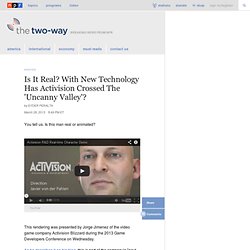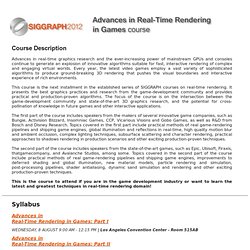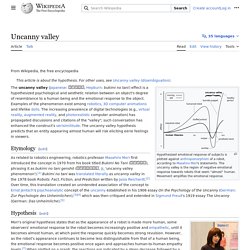

Beyond The 'Uncanny Valley' Activision R&D Real-time Character Demo. Activision Shows Off Animated Human That Looks So Real, It's Uncanny. Activision showed off the state of the art of real-time graphics on Wednesday, releasing this mind-boggling character demo.

The character's skin, facial expressions and eyes look so real, it's uncanny. When you watch this video, see if you think this character has reached the other side of what's commonly called the "uncanny valley," a term first uttered by early robotics guru Masahiro Mori in 1970. Is It Real? With New Technology Has Activision Crossed The 'Uncanny Valley?' : The Two-Way. You tell us.

Is this man real or animated? This rendering was presented by Jorge Jimenez of the video game company Activision Blizzard during the 2013 Game Developers Conference on Wednesday. As he describes it on his blog, this is part of the company's "next-generation character rendering" and is the "culmination of many years of work in photorealistic characters. " We're no experts, but it seems we've crossed some kind of threshold in animation, where what's real and animated is close to impossible to tell apart. Quiz: Is This a Video of a Human? - Megan Garber. Welcome to the Uncanny Valley -- population: this guy.

Any sufficiently advanced technology, Arthur C. Clarke argued, is indistinguishable from magic. There could be a corollary to Clarke's law, though, when it comes to one particular kind of technology: animation. Because when that technology becomes sufficiently advanced, apparently, it becomes indistinguishable from THE DEMONS THAT HAUNT YOUR NIGHTMARES. My evidence is the video above -- a proof-of-concept animation from the gaming company Activision. The creature you see before you, in other words, represents a kind of convergence among video forms, an A/V Turing test. Jorge Jimenez – Blog – Graphics Programmer Blog. The full source code of SMAA has been finally released, including SMAA S2x and 4x!

Checkout the subpixel features section of the movie to see the new modes in action (or download the precompiled binary). We are also happy to officially announce that all the nuts and bolts of the technique will be presented on EUROGRAPHICS 2012, in Cagliari (Italy). The paper is now much easier to follow, and has updated content. To all who tried to read the technical report and failed to deeply understand all the details, we definitely encourage them to give the EUROGRAPHICS version a try, as it does a much better job at explaining the core concepts and implementation details.
We’d like to thank all the community that is supporting SMAA, and give special thanks to Andrej Dudenhefner, whose hard work made InjectSMAA possible, allowing to use SMAA 1x in a lot of already published games. Advances in Real-Time Rendering in 3D Graphics and Games. Advances in Real-Time Rendering in 3D Graphics and Games - SIGGRAPH 2012. Advances in real-time graphics research and the ever-increasing power of mainstream GPUs and consoles continue to generate an explosion of innovative algorithms suitable for fast, interactive rendering of complex and engaging virtual worlds.

Every year, the latest video games employ a vast variety of sophisticated algorithms to produce ground-breaking 3D rendering that pushes the visual boundaries and interactive experience of rich environments. Uncanny valley. In an experiment involving the human lookalike robot Repliee Q2 (pictured above), the uncovered robotic structure underneath Repliee, and the actual human who was the model for Repliee, the human lookalike triggered the highest level of mirror neuron activity.[1] Etymology[edit] The concept was identified by the robotics professor Masahiro Mori as Bukimi no Tani Genshō (不気味の谷現象) in 1970.[5][6] The term "uncanny valley" first appeared in the 1978 book Robots: Fact, Fiction, and Prediction, written by Jasia Reichardt.[7] The hypothesis has been linked to Ernst Jentsch's concept of the "uncanny" identified in a 1906 essay "On the Psychology of the Uncanny".[8][9][10] Jentsch's conception was elaborated by Sigmund Freud in a 1919 essay entitled "The Uncanny" ("Das Unheimliche").[11] Hypothesis[edit]
